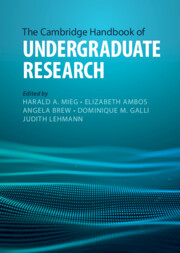Book contents
- The Cambridge Handbook of Undergraduate Research
- The Cambridge Handbook of Undergraduate Research
- Copyright page
- Contents
- Figures
- Tables
- Contributors
- Foreword
- Foreword
- 1 Introduction
- Part I Theory and Research on Undergraduate Research
- Part II Implementation, Approaches, Methods
- Part III Disciplines
- Part IV International Perspective
- 47 Introduction
- Part IV.1 Americas
- Part IV.2 Africa & Middle East
- Part IV.3 Asia & Oceania
- 58 Undergraduate Research in China
- 59 Undergraduate Research in India
- 60 Undergraduate Research in Indonesia
- 61 Undergraduate Research in Japan
- 62 Undergraduate Research in Australia
- 63 Undergraduate Research in New Zealand
- Part IV.4 Europe
- Part V Avenues for Developing Undergraduate Research
- Index
- References
61 - Undergraduate Research in Japan
An International Cultural Hybrid
from Part IV.3 - Asia & Oceania
Published online by Cambridge University Press: 11 August 2022
- The Cambridge Handbook of Undergraduate Research
- The Cambridge Handbook of Undergraduate Research
- Copyright page
- Contents
- Figures
- Tables
- Contributors
- Foreword
- Foreword
- 1 Introduction
- Part I Theory and Research on Undergraduate Research
- Part II Implementation, Approaches, Methods
- Part III Disciplines
- Part IV International Perspective
- 47 Introduction
- Part IV.1 Americas
- Part IV.2 Africa & Middle East
- Part IV.3 Asia & Oceania
- 58 Undergraduate Research in China
- 59 Undergraduate Research in India
- 60 Undergraduate Research in Indonesia
- 61 Undergraduate Research in Japan
- 62 Undergraduate Research in Australia
- 63 Undergraduate Research in New Zealand
- Part IV.4 Europe
- Part V Avenues for Developing Undergraduate Research
- Index
- References
Summary
Even though Japan has a largely Westernized system of education, it is worth remembering that this country has a strong hierarchical Confucian tradition of master–student relationships. This relationship is underlined by the literal meaning of sensei, “the one born before,” as the honorific given to all teachers and professors. University lecturers enjoy significant autonomy, and there are no particular barriers to faculty integrating undergraduate research (UR) into the curriculum. It can be argued that the STEM areas in which Japan excels have historically created more opportunities for research, and that UR is already undertaken there, whether formally recognized or not. In the arts, humanities, and social sciences, students are required to write a graduation thesis or report under the guidance of their instructor.
Keywords
- Type
- Chapter
- Information
- The Cambridge Handbook of Undergraduate Research , pp. 557 - 564Publisher: Cambridge University PressPrint publication year: 2022



